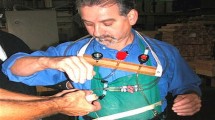Abstract Objective:
To analyze whether indices of nasal airway inflammation in bakers were related to nasal symptoms and exposure to airborne flour dust. Methods: A cross-sectional study was performed in 12 currently flour-exposed bakers. They were examined by nasal lavage (NAL), visual inspection, a test of mucociliary clearance, and nasal peak expiratory flow (nasal PEF). NAL fluid was analyzed according to the inflammatory markers eosinophil cationic protein (ECP), indicating eosinophilic activity; myeloperoxidase (MPO), indicating active neutrophils; hyaluronic acid (HA) from active fibroblasts; tryptase, indicating activation of mast cells; and albumin, indicating plasma exudation. The bakers were also questioned about respiratory symptoms and working history. Their current and cumulative exposure to inhalable flour dust was estimated after exposure measurements and information about earlier work tasks. Office workers (n = 16) without occupational exposure to dust or any other known nasal irritant or sensitizer served as controls. Results: Personal inhalable dust measurements among the bakers working as dough makers or bread formers ranged from 1.0 to 3.8 mg/m3. Of the 12 bakers, 10 reported at least 1 nasal symptom (crusts, blockage, or a runny nose), a proportion significantly greater than that of the controls (P = 0.009). Bakers with nasal symptoms had higher concentrations of markers of inflammation in their NALs as compared with nonsymptomatic bakers. The difference was significant for MPO (P = 0.02) and HA (P = 0.04) in relation to a runny nose. Tryptase was detected in only one NAL of the bakers. There was a positive correlation between the cumulative dose of inhalable flour dust and concentrations of MPO and HA in NAL. Two bakers were sensitized to wheat; they had the highest NAL concentrations of inflammatory markers. Conclusions: Our results indicate that flour dust exposure in bakers at levels below the current occupational exposure limit causes nasal mucosal inflammation, which, in turn, is related to nasal symptoms. We propose that the inflammation may be nonallergic, characterized by activation of neutrophils and fibroblasts.
Similar content being viewed by others
Author information
Authors and Affiliations
Additional information
Received: 16 September 1997 / Accepted: 16 May 1998
Rights and permissions
About this article
Cite this article
Brisman, J., Torén, K., Lillienberg, L. et al. Nasal symptoms and indices of nasal inflammation in flour-dust-exposed bakers. Int Arch Occup Environ Health 71, 525–532 (1998). https://doi.org/10.1007/s004200050318
Issue Date:
DOI: https://doi.org/10.1007/s004200050318




